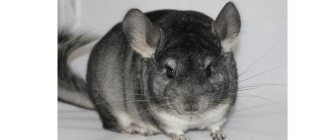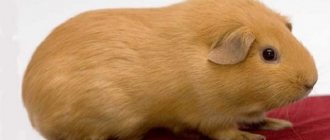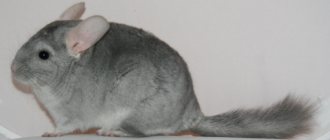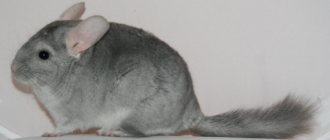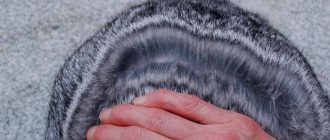Many believe that chinchilla breeds are fiction, and that the animals can be exclusively gray, the way they are most often seen in pet store windows and in photos on the Internet. However, this opinion is wrong. Breeders have been working for decades to ensure that the breeds and shades of these funny rodents only increase.
Below we will introduce you to the varieties of chinchilla colors and their breeds offered in nurseries.
Chinchilla breeds
These domesticated rodents are divided into two varieties, which have their own characteristics in the structure of the body and the length of the tail:
- Large short-tailed Peruvian chinchillas came to us from Bolivia and Argentina. These places are their homeland, and there they live in the wild, but only in protected areas, since local residents exterminate them for their valuable fur. In addition to nature reserves, they are also grown on specialized farms. Short-tailed chinchillas not only have dense fluffy fur, but also a fairly strong body. Standing on its hind legs, the animal reaches a height of up to 40 centimeters and weighs about 800 grams. The tail of large rodents is short, covered with stiff, short hair.
- Coast long-tailed chinchillas are common in Chile. They have a small body and a long tail covered with dense fur. Their weight does not exceed 700 grams.
Both chinchilla breeds are light gray in color. However, thanks to the efforts of breeders, long-tailed chinchilla rodents can now boast a huge variety of shades of their magnificent skin.
Angora chinchilla
One of the subspecies of long-tailed animals is the Angora royal chinchilla. It was not bred artificially. The rodent appeared thanks to the efforts of nature itself.
The animal was first noticed in the sixties of the last century. But he was included in the breed directory only in 2001. It is extremely difficult to breed this subspecies in artificial conditions, since the children from the male and female of this breed of chinchillas do not always turn out to have long hair; they often have short hair. It is for this reason that breeding Angora dogs requires the breeder not only to be professional, but also to carefully select pairs.
Angoras have silky long fur and a luxurious tail. In addition, they have long hair on their heads and paws. This breed of chinchilla has a flattened muzzle, which is why people call them Persian. The animals themselves are black, blue, diamond and purple.
“Angora chinchillas are the most expensive of all. The price of one individual is over 50 thousand rubles. The domestic animal has such valuable fur that the high cost of rodents has remained so for decades.”
Dwarf chinchilla
Mini chinchillas are also a natural genetic mutation. These animals have a small body, short legs and a bushy tail. The weight of rodents does not exceed 300 grams.
Dwarf domestic chinchillas give birth to the same cubs as their ordinary counterparts, so childbirth is difficult to endure. In most cases, babies do not survive. The animal must be under the supervision of a veterinarian throughout pregnancy. The shades of these cute animals can be different.
Pros and cons of content
Taming a chinchilla is not an easy path
Before you get a chinchilla, you need to understand that this is a wild animal that is difficult to tame . But just watching him is a lot of fun. These animals are distinguished by their dexterity of movement and good jumping ability. They are quite shy, which requires gradual accustoming of the animal to the presence of the owner.
It is not recommended to let your chinchilla out for a walk if the place for it has not been prepared in advance. She can easily climb objects located at the level of the window sill and above, and slip into any crack.
These charming animals can demonstrate different character traits: obedience, cunning, perseverance. On average, chinchillas live up to 20 years in natural conditions.
Pros of content:
- absence of odor in animal urine and excrement;
- the ability to tame an animal and teach simple tricks;
- Chinchillas have no sweat glands, due to which the fur coat is always clean and odorless;
- rapid reproduction, which makes it possible to make a profit from the sale of offspring;
- unpretentiousness in food and maintenance;
- the pleasure of communicating with the animal and observing it.
Minuses:
- animals are nocturnal, and at appropriate times begin to become active, which may interfere with the owners’ rest;
- like any rodent, they taste all the objects they come across;
- the need to maintain a stable temperature in the room with the enclosure, since changes can cause the animal to get sick;
- do not like to be held by a person;
- They are curious and strive to explore the entire territory when walking.
Varieties of colors
Since chinchillas have a lot of enemies in the wild, for their own safety, rodents have a light gray color, inconspicuous among rocky terrain.
Gray is the standard color for these cute animals, but artificially bred chinchilla breeds come in a wide variety of shades. Among them there are black, beige, white and even blue tones of chinchilla fur. Therefore, it is now extremely difficult to imagine that chinchillas originally had only gray colors.
All shades of chinchilla fur can be grouped as follows:
- gray or agouti: two shades that are standard;
- white, having different saturation and an admixture of beige and pinkish;
- brown or pastel, available in a full range of colors up to dark chocolate;
- black with varying degrees of saturation;
- purple, pink and sapphire.
In addition, it should be taken into account that fur colors differ not only in color, but also in:
- recessive. When a chinchilla is only a carrier of the gene responsible for the shade of its coat.
- dominant. When the color is already there and visible from birth.
When breeding rodents, it is extremely important to know what recessive color the male chinchilla and the female selected for mating have.
Rodents with gray color
Gray standard
Gray chinchillas are found both in the wild and in captivity.
Breeders divide them according to the color itself and its depth. Gray chinchillas are:
- light gray;
- medium gray;
- dark;
- moderately dark;
- extra dark.
Gray coloring is standard for chinchillas living in the wild and in domestic environments. The back of rodents is dark, the sides are light, and the belly is white. The wool has two shades. It is gray-blue at the base and black at the ends of the hairs.
Individuals of gray shades, unlike other rodents, are distinguished by very good health. In addition, the age of chinchillas of this shade to bear their first offspring is much lower than that of other subspecies. They can be crossed with absolutely any variety. Rodents have fur that is delicate and soft to the touch.
Light gray
Light gray fur with a silver tint looks very impressive. These chinchillas have a light chest, belly and limbs.
Medium gray
The most common color. The body of the animals has a uniform gray tint, the fur on the stomach, limbs and chest is light.
Dark
The fur has a gray tint with a bluish tint. The belly and chest of rodents are light, standing out well against the background of the rest of the fur.
Moderately dark
The fur of rodents has a dark gray tint, turning into ashy on the face, limbs and sides. Chinchillas have a bluish-white belly.
Extra dark
Many breeders prefer charcoal gray chinchillas with light sides and chest. The belly of this subspecies of rodents is almost white.
Other colors
In addition to the above, there are other colors of chinchillas, photos of which you can see below. They are recessive, so such individuals are rare and highly prized. These include:
- sapphire;
- albino;
- foggy;
- charcoal.
The fur of those with the Sapphire color is gray, but has a pronounced blue tint, and the animal’s belly is white. The peculiarity of such animals is that their coats remain colored throughout their lives; they do not darken with age.
Albinos lack any pigment, so their fur is snow-white, without mosaic spots or transitions, and their eyes are red.
Rodents with a foggy (hazy) color have a gray coat on which a blurred pattern can be distinguished; it can be a tone lighter or darker than the main one. The animal's eyes are dark.
Chinchillas with light colored fur
Chinchillas with a white coat simply look luxurious and elegant. They have a number of unusual shades.
White Wilson
Chinchillas have white fur mixed with white or beige. You can purchase such an animal at a nursery or from breeders at home. The color is in demand among connoisseurs of these rodents.
Albino
These chinchillas do not have color pigments at the genetic level, so they have a snow-white tint and a red iris.
White lova
Chinchillas have white fur with a slight cream tint and dark ruby eyes.
White velvet
These animals have light fur that is velvety to the touch. Boy chinchillas often have a silver tint, while girls have a beige tint. In addition, they have distinctive gray spots on the head and limbs.
White-pink
The description of these chinchillas is as follows. Animals with milky white fur, pinkish ears and beady black eyes. However, there are representatives of this species that have a pink stripe on the back.
Pink White
White-pink is a very beautiful color that carries three genes:
- White.
- Beige.
- Standard.
And it is the first gene that is responsible for the manifestation of mosaic pattern: gray-brown spots on the surface of the fur. Sometimes there are beige individuals with whitish spots or stripes. The ears of white-pink individuals are pinkish, sometimes there are freckles, and the eyes are bright or dark red.
Due to the presence of a lethal gene, such animals cannot be paired. With the exception of this feature, otherwise such individuals will be excellent partners for rodents with other coat colors.
Animals with beige fur
The main shade of these rodents is pastel. However, it has several variations. Additionally, the older the chinchilla, the darker its fur will be. It can be brown, red or beige. This type of rodent can be crossed.
Homobeige
This species of rodent has light beige fur with uniform coloring and pink ears. For this shade, single dark hairs are acceptable.
Heterobeige
In these rodents, on the contrary, the color is uneven. The entire coat is beige, and the undercoat and ends of the hairs are brown. When choosing a chinchilla, you should pay attention to the color distinction between the rest of the body and the belly.
Beige tower
The color of the fur of these animals varies from light to dark beige, which is combined with a brown pattern located along the spine.
Wellman beige
The chinchilla has light beige fur, light ears and dark eyes.
Beige Sullivan
Rodents have rich beige fur and red eyes.
Brown velvet
The basic fur color of these animals is beige, while the back and head have a chocolate tint, and the belly is sandy.
Chinchilla ebony
These animals are distinguished not by a certain color, but by the quality of their skin. If you bring the rodent to the light, the fur begins to shine and shimmer. The color palette of such chinchillas is quite diverse.
Homoebony
Chinchillas of this color have black fur and black eyes. Also, the color of these animals has a second name - charcoal.
Heteroebony
These rodents combine two shades: black and gray. They are very impressive and often take first place at exhibitions.
White ebony
Chinchillas have snow-white fur with a black coating at the ends of the hairs. The limbs, head and base of the tail may have a beige tint.
Chinchillas with dark fur
These rodents include black velvet chinchillas with rich black fur and a white belly.
Black velvet
This color combines black and white. The animals have a black body and tail, and a white belly. This contrast looks very impressive and the clearer the color boundaries, the higher the price of a chinchilla and the more valued the breed is.
This species of rodent was bred in the 60s of the last century. Breeders believe that the dark skin is evidence of the high quality of the breed. Chinchillas may have light stripes on their limbs, a charcoal mask, and dark fur on their heads.
The older a rodent gets, the more pronounced its breed characteristics become. Since the black fur gene is lethal, crossing with representatives of your own breed is unacceptable; black chinchillas can only be mated with rodents of other colors.
How to choose a kitten
- Kittens of corpulent breeds such as British and Scottish cats grow very unevenly. Accordingly, when going to the nursery, calmly accept the fact that two-month-old babies look extremely cute, but six-month-old teenagers have a very unsightly appearance.
- When buying a Scottish Fold chinchilla, conduct a thorough inspection of its limbs. If a kitten has too short legs and a tail, these are signs of impending osteochondrodysplasia.
- Many chinchilla colors are unstable and can change the saturation of the tone, so if you are afraid to miss, choose cats over the age of 1 year.
- Be sure to meet the kittens' mother. If the breeder stubbornly hides the female breeder, this is a reason not to conclude a deal. You should also not take babies who, for some reason, were raised not by the cat, but by the breeder himself - kittens that did not feed on mother's milk in the first month of life have weak immunity and run the risk of contracting an infectious disease.
- Assess the condition of the animal's coat. A purebred chinchilla should not have bald spots or areas with sparse hair.
Rare colors of chinchillas
The most expensive and valuable animals have a rare, very beautiful color. Breeders managed to breed several breeds, looking at which it is simply impossible to contain delight.
Violet
Rodents have a light lilac coat, contrasting with a white belly. The ears and nose of the animals have a purple tint. When crossed, the unusual color is passed on only in the first and second generations. Purple chinchillas mature late and can mate only after one and a half years.
Sapphire
The fur of these animals can be either bluish-gray or light blue with a light graphite coating. Chinchillas have a white belly and black eyes. The animals are among the most expensive and sought after among breeders. The unique coloring does not appear immediately, but only by 8 months. To purchase a real sapphire chinchilla, it is better to purchase the rodent from a licensed nursery.
Blue Diamond
Chinchillas have light blue fur with a metallic sheen. There is a dark stripe along the ridge and head.
White and pink diamond
One of the rare colors is pearl with a pinkish tint. The color of such chinchillas' fur resembles pearls. The exception is the ears, which have a pinkish tint. The pearl gene is lethal, so representatives of the same breed cannot be crossed. Chinchillas of other colors are suitable for mating.
Violet
Violet is a very beautiful rodent, the species carries a white gene and two purple ones. Often confused with Wilson White, but the main difference is in the coloring of the spots; Wilson’s are gray.
In normal light, the fur coat of these individuals has a purple tint, which imparts a special charm due to its sparkle. Under artificial light it becomes steel gray. The belly, like the standards, is snow-white. There are White and Gray Violet. The first may have various purple spots on the fur, their shade most noticeable at the tip of the tail.
The quality of the coloring is characterized by an even, bright rosette, which is ensured by the color of the base of the hairs in a gray-violet color, the light middle part and the tip from light purple to bright purple. The color intensity of an adult animal’s coat can be determined at birth, and the final color appears by the seventh or eighth month.
When choosing a pair for your purple pet, consider the following recommendations:
- to get a beautiful pet, choose light standards;
- the purple gene is passed on in both the first and second generations;
- due to the recessivity of violet, when crossed with non-violet, the offspring will only be a carrier.
Animals with purple fur reach maturity late. But despite the ability to reproduce only after 14-18 months, such animals are very popular.
Breeding chinchillas
Thanks to the wide variety of rodent colors, breeders have plenty of opportunities to develop new breeds. Crossbreeding itself is a unique process, because you never know whether the babies may display a recessive gene from one of the parents. However, there are also restrictions on mating individuals. For example, there are two lethal genes: black and white. They cannot be combined, otherwise not only the babies, but also the female herself may die while carrying them.
"Note! To carry out successful crossbreeding, all breeders have passports for their animals. The documents indicate what genes their pets have, and also indicate the possible color of their future babies.”
Results
Breeding chinchillas is a very profitable business. However, in order to become an experienced breeder, you should take into account not only the breeds of chinchillas and their colors, but also know all the intricacies of the care and nutrition of these magnificent animals.
Gray and beige rodents are easier to breed, they are more common, and their babies are cheaper than, for example, sapphire and purple ones. Crossing and breeding chinchillas is an extremely complex process, so it needs to be approached wisely and only done by those people who are truly interested in it. You should not do this for the sake of banal profit, since nothing good will come from such a business.
Not only breeders, but also scientists around the world are engaged in breeding new breeds. They are driven to this by the popularity of rodents not only as pets, but also by their breeding as specimens to obtain valuable fur.
Keeping a chinchilla at home is not very easy, but it is worth it. The animals love their owners very much and treat them with tenderness and love. Breeders advise purchasing chinchillas in pairs, because there is nothing more pleasant than watching their games, affection, love and friendship, which a person can only envy.

